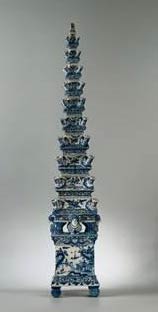Human Flower Project
Friday, February 23, 2007
Tulips in Harness
How do you handle a blossom worth 12 sheep? Singly, elegantly, in a porcelain corset.
 Pyramid vase
Pyramid vase
c. 1690-1720
Artist unknown
Photo: Rijksmuseum
At the height of tulipomania (1634-1637) one tulip bulb cost as much as 4 oxen or 1000 pounds of cheese. Once those bulbs bloomed, Dutch flower arrangers couldn’t just flop such high-stakes blossoms inside any old milk bottle. Holland’s tulip fiends collaborated with the ceramicists of Delft to produce the tulipiere—an uber-vase designed to show off a bunch of precious flowers to their best individual advantage.
With tulip season nigh in the Southern U.S., Mariana Greene of Dallas features tulipieres today. You may have seen these puzzling things in antique shops. They sometimes look like upward udders or carburetors—vessels with not one opening but several protuberances, each meant to hold a single bloom.
The most magnificent one we know of is this smashing Pyramid vase in the collection of the Rijksmuseum in Amsterdam. Curators date it from 1690-1720, after the speculative trade in tulips crashed. (Whoever owned this piece must have sold at the right time.) More than three feet high, it’s actually a construction of 6 separate vases and can hold forty flowers—tulips or roses or what you will. “Mr. van Os, I’m ready for my close up.”
 Tulipiere
Tulipiere
Photo: Photos by Evans Caglage
for Dallas Morning News
What sophisticates these flowers are. The bulbs, native to the Near East, were brought by a diplomat to Vienna and then to the Netherlands in the late 16th century. The tulipiere shape seems to have been born in Europe but typically was decorated with designs from Chinese porcelain. Subsequently, Chinese ceramicists began producing tulip vases of their own.
It wasn’t floral price alone that that inspired these peculiar vessels. If you’ve ever had tulips you know that once they’re cut and set in water, they keep growing, and have a way of dipping and straining toward the light. The tulipiere serves as a kind of harness, reining their wanderlust in.
 Tulipiere, 2005
Tulipiere, 2005
by Janet E. Kastner
Photo: University of Texas Fine Arts
Here’s a pretty pair from the 18th century, a pink lady, and Deidre Daw’s five foot Diphthong Vase, ready for some of Ecuador’s stilt-stemmed roses.
Should you not have a tulipiere, you can search out an antique, buy a reproduction in the Delft style, or even find a contemporary piece, like this one with Las Vegas dancers. And if harnessed flowers don’t appeal to you, here are other ideas for arranging the globetrotters of spring.
Art & Media • Culture & Society • Cut-Flower Trade • Florists • Permalink




